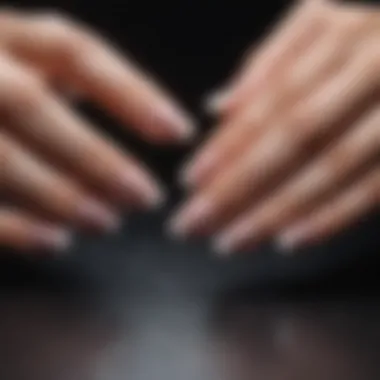Mastering DIY Dip Nails: A Complete Guide


Intro
Nail care has evolved, with many women seeking ways to achieve salon-quality results at home. DIY dip nails have gained popularity. They offer durability and long-lasting shine, making them a preferable choice. In this guide, we explore the various components of executing this technique.
Understanding the preparation, tools, and methods involved is essential for a successful outcome. This article serves not just as a step-by-step guide but as a resource for every woman interested in elevating her nail routine. By discussing potential challenges, we aim to equip you with the knowledge necessary to navigate the DIY dip nail process effectively.
Intro to DIY Dip Nails
As the demand for home beauty solutions rises, the concept of DIY dip nails has gained significant traction. This article aims to guide readers in understanding the methodology and nuances involved in creating dip nails at home. Dip nails, when applied correctly, can yield professional results at a fraction of the cost of salon visits. Through exploring the essential tools required, application techniques, and aftercare, this guide underscores how DIY dip nails can improve personal nail care regimens.
What Are Dip Nails?
Dip nails refer to a nail enhancement process where the natural nails are coated with a base layer, followed by dipping into colored powder, and sealed with an activator or top coat. This technique originated as an alternative to traditional acrylics, providing a strong and durable finish. Unlike regular nail polish, dip nails can last longer, often between three to four weeks, making them a popular choice for individuals seeking longevity without the frequent touch-ups. The resulting finish is glossy and can be as vibrant or subtle as one desires, depending on the color selection.
Benefits of DIY Dip Nails
The benefits of applying dip nails at home are multifaceted:
- Cost-Effective: DIY dip nails are significantly cheaper than professional services. The initial investment in tools and products quickly recoups over time.
- Customization: Individuals have full control over their color and style choices, allowing for unique and personalized nail art.
- Convenience: Performing nail enhancements at one's leisure eliminates the need to schedule and travel for salon appointments.
- Less Odor: Compared to gel and acrylic systems, dip powder systems typically have less odor, creating a more pleasant application experience at home.
Common Misconceptions
Several myths surround the practice of DIY dip nails that can dissuade potential users:
- Difficulty Level: Many believe that achieving a salon-quality finish requires professional skills. However, with practice, the technique can be mastered by anyone.
- Nail Health Concerns: Some may worry about the potential damage from dip nails. In fact, when applied and removed properly, the risk of damage is minimal.
- Temporary Nature: Another misconception is that dip nails will not last long. In reality, with proper care, dip nails can remain intact for weeks without chipping, rivaling traditional nail polish in durability.
"The essence of DIY dip nails lies in their accessibility and the empowerment they offer - transforming personal nail care into an achievable craft."
This comprehensive exploration delves into these aspects, offering a thorough understanding of what DIY dip nails entail and why they are becoming an integral part of modern nail care practices.
Required Tools and Products
In the realm of DIY dip nails, understanding the right tools and products is essential. They directly impact the ease and quality of the process, making the difference between a polished finish and an unsatisfactory result. Having the correct tools at your disposal allows for better application, reduces potential errors, and can lead to a more durable outcome. Not only does this save time and effort, but it also provides an opportunity to express creativity through color and design.
Essential Tools for Application
Nail file and buffer
The nail file and buffer serve as a cornerstone of the preparation process. A nail file shapes and smoothes the edges of the nails, allowing for a clean canvas. Meanwhile, the buffer polishes the nail surface, which enhances adhesion when applying dip powder. A popular choice is the multi-sided buffer as it offers various grit levels for different purposes. The unique feature of this tool lies in its ability to refine imperfections, enabling a seamless application. However, excessive buffing can weaken nails, so precision is key.
Cuticle pusher
Using a cuticle pusher is vital for achieving a professional look. This tool helps to gently push back the cuticles, exposing more of the nail and ensuring a clean application. The primary advantage of a well-made cuticle pusher is its capacity to prep the nail without causing trauma to the surrounding skin. Metal and wooden options are available, with the wooden ones being softer on the nails. However, one must be cautious not to overuse it, as this can lead to irritation or even injury.
Nail polish remover
Nail polish remover is necessary for any DIY project, serving multiple purposes. Primarily, it cleans the nail surface, which is crucial for optimal adhesion of the dip powder. A non-acetone remover is often preferred due to its gentler nature, making it suitable for those with sensitive skin. Nevertheless, acetone removers act quicker but can dry out the skin and nails, presenting a trade-off. A careful choice can enhance the overall nail health while ensuring that the dip nails adhere properly.


Recommended Dip Powder Systems
Brand comparisons
When selecting dip powder systems, comparing brands is essential for making an informed decision. Popular brands like Kiara Sky, DipWell, and Revel Nail each offer distinct formulas and colors. These comparisons highlight differences in staying power, ease of use, and finish quality. It’s beneficial to read reviews and perhaps try starter kits from various brands to identify which suits your needs best. Avoid brands that lack transparency regarding ingredients, as this may affect nail health in the long run.
Color options
Color selection is more than just aesthetics—it's about expressing personal style. Dip powders come in a wide spectrum, enabling creativity and customization. Brands provide numerous shades, from classic reds to trendy pastels. Consider the season and occasion when choosing colors. This variety allows for seasonal and celebratory themes but requires careful thought, as some colors look different on the nail than in the container. Testing colors ahead of time can minimize mismatched expectations.
Other Necessary Supplies
Base coat
The base coat plays a critical role in the application of dip nails. It forms a bonding layer that enhances adhesion to the natural nail and prepares the surface for the dip powder. Choosing a high-quality base coat is essential, as it affects how well the dip powder adheres. Some base coats have added strengthening properties, which can be a significant advantage for those with brittle nails. However, improper application can lead to lifting.
Top coat
The final touch to any dip nail application is the top coat. It seals the dip powder, adding a glossy finish and enhancing durability. A thick, high-quality top coat can protect against chips and scratches. Some brands offer fast-drying top coats, which are beneficial for those pressed for time. A disadvantage worth noting is that thicker coats may take longer to dry compared to thinner ones.
Activator
Activator is a crucial component that ensures the dip powder solidifies properly. When applied after the powder, it helps bond the layers together. A good activator will cure the dip quickly, reducing overall application time. However, it's important to follow application instructions precisely, as over-application can lead to a cloudy finish. The right activator can make or break the quality of the dip nails, so consider brand recommendations carefully.
Preparation Steps Before Application
Preparation is a crucial phase when it comes to DIY dip nails. Taking the time to properly prepare your nails and workspace can greatly contribute to achieving a salon-quality finish. Understanding the steps involved will ensure that your dip nails not only look good but also last longer. This section will delve into assessing your nail health, creating a clean workspace, and gathering all necessary supplies.
Assessing Nail Health
Before starting the application, it is vital to check your nails for any signs of damage.
Signs of damage
Signs of damage include peeling, brittleness, or discoloration. These indicators can show underlying issues that may affect the application of dip nails. Recognizing these signs is beneficial for ensuring the health of your nails. The key characteristic of damaged nails is their inability to hold product effectively. Neglecting damaged nails can result in poor adhesion and premature lifting, which ultimately undermine your efforts.
Additionally, damaged nails may not provide a smooth surface for application. This presents unique challenges during the dipping process, often resulting in an uneven finish. To prevent complications, it is wise to treat any issues before proceeding with dip application. This may involve moisturizing, nourishing, or even consulting a professional.
Prepping nails
Once you're aware of your nails' health, prepping them correctly becomes essential. This process may include filing, buffing, and cleaning the nail surface. The preparation phase contributes to the overall adhesion of dip powder. A key characteristic of well-prepared nails is smoothness. When nails are well-prepped, the dip powder adheres better and creates a lasting finish.
The unique feature of prepping nails is its straightforwardness. It requires no specialized skills, and the benefits are substantial. Well-prepared nails can enhance the effectiveness of each application while minimizing the risk of lifting. Thus, investing a little time into preparation leads to a noticeable improvement in the final result.
Creating a Clean Workspace
Creating a clean workspace is another significant step before starting your dip nails. A clutter-free environment not only promotes focus but also prevents the introduction of dust and contaminants. You should clean your table, ensuring that all surfaces are sanitized. Using alcohol wipes can effectively eliminate bacteria, creating a safe area for application. Organizing your tools and products within arm's reach will streamline the entire process.
Gathering Your Supplies


The final preparation step involves gathering all necessary supplies. Make sure you have your dip powders, base coat, top coat, activator, and any tools required for application. Having your supplies organized and ready can prevent interruptions. When gathering supplies, consider checking expiry dates, as some products can lose their effectiveness over time. To optimize your experience, it can be helpful to create a checklist before beginning your nail care process.
By emphasizing the significance of these preparation steps, you lay a solid foundation for an effective DIY dip nails application.
Step-by-Step Application Process
The step-by-step application process for DIY dip nails is crucial to achieving a flawless look at home. It allows the user to break down the larger task into manageable segments, ensuring each part of the application is done properly. Following a structured process can help prevent common errors, result in better durability, and enhance the overall aesthetic of the nails.
Begin with Nail Preparation
Nail preparation is perhaps the most important step. Clean nails are essential for a smooth finish. Start by washing your hands thoroughly and removing any traces of old polish or nail debris. Use a nail file to shape your nails to your desired length and form. It is also beneficial to lightly buff the surface of the nail to create a better bond with the dip powder.
Eliminating any oils or residues left on the nail bed is critical. A clean base allows for optimal adhesion of the dip products, which can significantly improve longevity. If there are any hangnails or rough spots on your cuticles, address those before diving in. You may use a cuticle pusher to push back the skin gently.
Applying the Base Coat
The base coat acts as a foundation layer that grabs onto the dip powder. After your nails are prepped, apply a thin layer of base coat across the entire nail, avoiding the cuticles as much as possible to prevent lifting. The consistency of the base coat can vary by brand, so aim for an even application. This step should not be rushed.
Once the base is applied, you can dip your nail into the dip powder at a 45-degree angle for only a few seconds. Tap the finger gently to remove any excess powder. The base coat is essential in providing a stable layer for all future applications, ensuring the dip adheres effectively to your nails.
Dipping Technique Explained
The dipping technique can be a bit tricky at first, but practice makes perfect. After applying the base coat, dip the nail into the powder. It’s essential to ensure that the nail is submerged fully and that the powder covers the entire base coat. After that, remove the nail and tap to get rid of any excess powder. This method not only creates a nice finish but also blends the layers seamlessly.
A common mistake is to dip the nail repeatedly into the powder without giving the base coat time to set. Give each dip a couple of seconds to adhere before proceeding. Repeat this process as needed until you achieve the desired color intensity.
Applying the Activator and Top Coat
After the dipping process, applying the activator is necessary to harden the powder. This step solidifies the dip powder, making it durable. Use the activator generously on all nails and wait for about two minutes for it to cure. Then, you can proceed with the top coat.
The top coat gives the nails a glossy finish and additional strength. Apply a layer of top coat evenly on your nails, sealing the edges to enhance longevity. Wait for the nails to cure again before moving on. By following these steps meticulously, you will achieve a finish comparable to a salon.
Finishing Touches
Once everything is set, take a moment to examine your nails for any imperfections. If needed, make minor adjustments or apply a second coat of top coat for added shine. It’s also beneficial to hydrate the cuticles with oil to maintain nail health and give a polished look.
The final appearance of the nails is what shows off all your hard work, so ensure that each nail is uniform and well-taken care of.
"Investing time in each step is essential for achieving a professional result at home."
Aftercare for Dip Nails
Aftercare is a critical element in ensuring the longevity and appearance of your DIY dip nails. Proper aftercare can greatly influence the durability of the nails and the overall health of your natural nails. Understanding how to maintain your dip nails helps avoid common pitfalls such as chipping or lifting, and ensures that your nails continue to look fresh.
Maintaining the Finish
To maintain the finish of your dip nails, there are a few key practices to keep in mind:
- Avoid excessive water exposure: Prolonged contact with water can weaken the bond of dip nails and result in lifting. When washing dishes or bathing, consider wearing gloves to protect your nails.
- Use moisturizing products: Keeping your nails and cuticles well-hydrated is essential. Apply cuticle oil regularly to prevent dryness and cracking. This can also enhance the shine of your dip nails.
- Be gentle: Avoid using your nails as tools. Actions like opening cans or prying open packages can damage the dip powder and ruin the finish. Treat your nails with care, as they are delicate.


Regular aftercare not only extends the life of your dip nails but also promotes the health of your natural nails.
Proper Removal Techniques
Proper removal techniques are just as important as application. Incorrect removal can lead to damage to your natural nails. Here are the steps to safely remove dip nails:
- Buff the Surface: Start by gently buffing the top layer of the dip nails. This helps in breaking the seal and allows the acetone to penetrate.
- Soak in Acetone: Soak cotton balls in acetone and place them on top of each nail. Wrap the nails with aluminum foil to keep the cotton in place and maintain warmth, aiding the removal process.
- Wait: Let the nails soak for about 15-20 minutes. This duration allows the dip powder to dissolve effectively.
- Gently Scrape Off: After soaking, gently push the dip powder away with a cuticle pusher. Avoid excessive force, as this can harm your natural nails.
- Hydrate After Removal: Once the dip nails are removed, cleanse your nails thoroughly with soap and water, then apply a nourishing cuticle oil or hand cream to restore moisture.
Following these removal guidelines will help prevent any damage and ensure your nails remain healthy and ready for your next DIY dip nail session.
Troubleshooting Common Issues
Understanding common issues in DIY dip nails is essential for achieving a flawless finish. Despite following the right steps, problems can still arise, leading to dissatisfaction with the results. This section aims to provide clarity on the most frequent issues encountered during the application and maintenance of dip nails. By addressing these problems, you can enhance your technique and enjoy longer-lasting results.
Dealing with Air Bubbles
Air bubbles can form during the dipping process, leading to an uneven surface and compromised adherence. These bubbles generally arise from either improper application technique or the state of the dip powder itself. To avoid this issue, ensure you gently apply each layer of dip powder, working from the base of the nail to the tip.
- Sprinkle, Don’t Dunk: For optimal results, lightly sprinkle the dip powder over the nail rather than aggressively dipping it. This reduces the chances of trapping air.
- Patience is Key: Allow each layer of powder to dry slightly before applying the next. This can help minimize air bubbles forming in subsequent layers.
- Check Your Product: If air bubbles persist, consider inspecting the quality of your dip powder. Expired or low-quality powders are more prone to air contamination.
Avoiding Lifting of Dip Powder
Lifting occurs when the dip powder begins to separate from the natural nail. This issue compromises the overall appearance and longevity of the nails. To minimize lifting, the following practices are beneficial.
- Proper Nail Prep: Start with an impeccable nail preparation routine—this includes filing and buffing the nail surface and removing oils that could prevent proper adhesion. Tools like a nail file or buffer can be crucial for this step.
- Adhere to Recommended Products: Always use base and top coats designed specifically for dip nails. Each brand often has compatible systems that work better together.
- Seal the Edges: Make sure to seal the tips of the nails with top coat to add a protective barrier against wear and tear.
Ensuring Durability
Durability of dip nails is a paramount concern for those transitioning from salon visits to home applications. If not maintained, nails may chip or wear prematurely. Here are some steps to ensure long-lasting dip nails:
- Hydration is Important: Keep cuticles moisturized with a good cuticle oil; this can prevent dryness that may lead to chipping.
- Gentle Care: Be cautious with the hands, especially when doing household chores. Wearing gloves can protect the nails from harsh chemicals that can degrade the dip powder.
- Regular Maintenance: Regularly check your nails for any signs of damage or wear. Addressing minor chips early can prevent larger issues later on.
"Investing time in troubleshooting issues can lead to a more satisfying DIY dip nails experience. This allows you to refine your technique and achieve the durable, salon-quality finish you desire."
In summary, troubleshooting any issues during the DIY process is vital for maintaining the quality and appearance of dip nails. Identifying and addressing problems such as air bubbles, lifting, and durability not only enhances the outcome but also extends the lifespan of your manicure.
Finale on DIY Dip Nails
In summary, the conclusion on DIY dip nails illustrates the core significance of mastering this technique. The method is not only a cost-effective alternative to salon visits, but it also empowers individuals to personalize their nail care routine. By engaging in the DIY process, one can cultivate self-expression through creative nail designs and colors.
Moreover, understanding the application and maintenance of dip nails leads to a better appreciation of personal grooming. A successful at-home manicure can boost confidence and satisfaction. Therefore, it is beneficial to remember that good preparation and proper aftercare enhance the longevity of the dip nails.
Final Thoughts
As you embark on your DIY dip nails journey, keep in mind the importance of patience and precision. These qualities can elevate your results tremendously. Each step carries its weight, ensuring not just a visually appealing finish but also the health of your natural nails. The careful selection of products and adherence to technique will result in a professional appearance without the hefty price tag.
It may also be helpful to follow tutorials or join online communities dedicated to nail care. Such resources can provide support and feedback, further enriching your DIY experience. Getting hands-on experience will inevitably bring a sense of fulfillment.
Encouraging Practice and Experimentation
The journey of learning DIY dip nails should invite curiosity and experimentation. Trying different colors, techniques, and designs can lead to discovering your unique style. The more you practice, the better you will become.
Do not shy away from making mistakes; they are part of the learning process. Each application teaches valuable lessons. Remember, nail art is an evolving medium, and your skills will improve over time.
Furthermore, share your experiences with others. Engaging with communities like reddit.com and various social media platforms can offer inspiration and new ideas. Your exploration will not only improve your skills, but it can also inspire others who are considering the same path.







